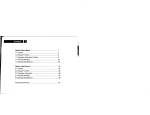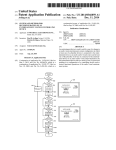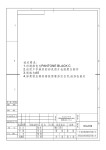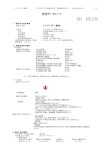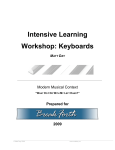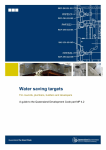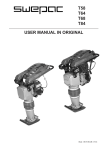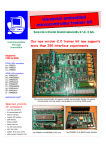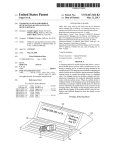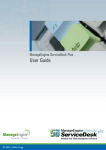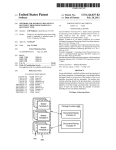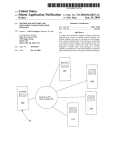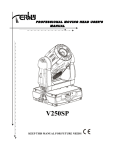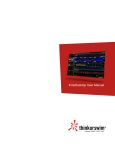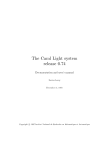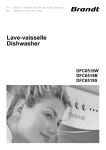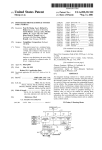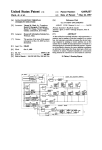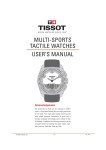Download 55W???
Transcript
US 20120047447A1 (19) United States (12) Patent Application Publication (10) Pub. N0.: US 2012/0047447 A1 Haq (54) (43) Pub. Date: EMOTION BASED MESSAGING SYSTEM (52) AND STATISTICAL RESEARCH TOOL (57) Feb. 23, 2012 US. Cl. ...................................................... .. 715/752 ABSTRACT A system that allows users to convey their emotional state of (76) Inventor; saad U] Haq, London (GB) mind by means of selecting their mood from a toolbar When using applications such as instant messaging, SMS, MMS, emails, blogs, commenting etc. Different moods appear as _ (21) Appl' NO" different icons or in a drop-doWn box as text. Emotion inten 12/805’873 sity can be changed by a sliding bar present on the toolbar. The sender Will have the option to display their mood for that _ (22) (51) certain message as an emotion label displayed With the mes Flled? Allg- 23: 2010 sage and also by message text formatting: font face and color Publication Classi?cation Int- ClG06F 3/01 (2006.01) are emotion dependant Whereas font siZe and tone (lighter/ darker shades for the same color) are intensity dependant. This messaging technique alloWs the recipient to gauge better the sender mood, it can also be used to dynamically determine population mood and extract and plot statistical data on mood/ emotion distribution maps, charts or graphs for analy G06F 15/16 (2006.01) sis, interpretation, research and marketing. m 33 55W??? I Patent Application Publication Feb. 23, 2012 Sheet 1 0f 16 US 2012/0047447 A1 Patent Application Publication Feb. 23, 2012 Sheet 2 0f 16 auaky I A?é swag US 2012/0047447 A1 Patent Application Publication Feb. 23, 2012 Sheet 3 0f 16 ?giim 3 US 2012/0047447 A1 Patent Application Publication Feb. 23, 2012 Sheet 4 0f 16 US 2012/0047447 A1 1 , '/ --1--"'I::;;;':-> ‘W E 35511;: J 2' :-" i, r‘ .-'.-" .................... .. S,- .. -------- “ 2' ‘I V 0 ~ 3 .\ Zi ............................... . . (I! "6-) Figum ?i of)" s. . . \ it ~ ; Patent Application Publication 1% Feb. 23, 2012 Sheet 5 0f 16 US 2012/0047447 A1 m 32 35; Wgmm 5 1% Patent Application Publication 33 Feb. 23, 2012 Sheet 6 0f 16 US 2012/0047447 A1 Patent Application Publication Feb. 23, 2012 Sheet 7 0f 16 éw‘??? biiim 'imiaw . or} my‘ item iii-11¢, 1 US 2012/0047447 A1 Patent Application Publication 3.1% Feb. 23, 2012 Sheet 8 0f 16 US 2012/0047447 A1 Patent Application Publication 5 c i Feb. 23, 2012 Sheet 9 0f 16 US 2012/0047447 A1 Patent Application Publication 35% Feb. 23, 2012 Sheet 10 0f 16 2Q 3g US 2012/0047447 A1 Patent Application Publication 33 Feb. 23, 2012 Sheet 11 0f 16 2Q US 2012/0047447 A1 z Patent Application Publication Feb. 23, 2012 Sheet 12 0f 16 Figure m US 2012/0047447 A1 Patent Application Publication Feb. 23, 2012 Sheet 13 0f 16 US 2012/0047447 A1 Patent Application Publication Feb. 23, 2012 Sheet 14 0f 16 US 2012/0047447 A1 Patent Application Publication Feb. 23, 2012 Sheet 15 0f 16 33 3% 3% 3% 3?? ?gum 35 US 2012/0047447 A1 Patent Application Publication Feb. 23, 2012 Sheet 16 0f 16 US 2012/0047447 A1 Feb. 23, 2012 US 2012/0047447 A1 EMOTION BASED MESSAGING SYSTEM AND STATISTICAL RESEARCH TOOL [0001] This invention relates to the use of emotion labels and associated attributes that alloW a user to specify their emotion on a certain subject at the time of Writing thus enabling a more personal and effective communication With the recipient and also providing statistical data on the mood of a user over a certain period of time on a certain subject. CONVENTIONAL MESSAGING METHOD [0002] Conventional text-based forms of communication over the intemet, intranet, extranet and telecommunication networks are Wide spread and are becoming increasingly common because of the increasing ease and advantages of accessing the intemet in our daily life, i.e. cheaper connection costs and rates. Moreover, communication over the internet has many forms namely; electronic mail, instant messaging, blogs, forums and commenting systems. These methods of expressing one’s self to another make up the mechanism of social networking, Which too has increasing in?uence and importance in our daily life. In this patent, the Word ‘messag ing’ Will be used to encompass all of the above forms. These methods involve typing text characters, symbols and/or attaching multimedia ?les. In this invention We Will concen trate on text Which usually forms the bulk of these messages. [0003] The problem With such conventional messaging is the user’s inability to ?llly express their emotion, mood or feeling Without otherWise explicitly mentioning it. It is true then that emotion can thus be expressed by text if the emotion is mentioned Within the body of the text, but on a large scale this method of reading each message to ascertain the per the intensity of the emotion can be varied by means of a sliding bar Which Will be made available to the sender only. Moving this sliding bar Would indicate hoW much of that particular moodthe sender is feeling. HoW this Will Work is by the use of pre?xes to the emotion related Word. The folloWing example is given for a certain emotion: A little happy, Happy, Very happy and Extremely happy. Please note that these pre ?xes Will be made standard for all emotions and also that the extreme right of the sliding bar is the upper extreme of an emotion, i.e. extremely . . . , and the extreme left is the loWer extreme, i.e. a little . . . . EMOTION TOOLBAR [0006] By the use ofa custom toolbar such as a text toolbar that contains font face, color, siZe and style (bold, italic, underlined etc.), this patent claims a similar independent toolbar that Will enable the user to specify emotion by pro viding various options, menus and icons Whose arrangement Will be based on hoW this system of specifying mood Works. The emotion toolbar Will contain the most common emotions as smiley icons Which can simply be clicked on if the user is feeling that Way. We have limited the number of most com mon emotions to three; happy, sad and angry, for the sake of space and convenience. HoWever, it is very much possible that the user is not feeling one of these three emotions, thus We have also created a drop-doWn menu that can be accessed by clicking on an arroW icon beside the three smileys. This menu Will have many more emotions or moods Written rather than depicted as smileys, Which Will be sub-classi?ed into various headings foruser convenience such as common, recent, latest, add neW and search. Since there are a very large number of ceived emotion is cumbersome. Searching for keyWords moods/emotions/ feelings, it Would be easier if they Were classi?ed in such a Way. The ‘Common’ heading Will contain seems to provide a solution. But, this method of identifying emotion-related Words like ‘happy’ is in fact inaccurate as that particular Word may not have been employed to describe the no more than ?fteen everyday emotions. ‘Recent’ Will contain those moods that the user often uses and also those Which he/ she has used last. The heading ‘Latest’ Will shoW all neW sender’s emotion. For example, consider the folloWing blog of a school student: “. . . remember hoW happy the teacher looked after We . . . ”, here mentioned is the Word ‘happy’, but emotions that have been added to the collection recently, since there are a very large number of emotions, it Would not be possible to exhaustively think of every emotion and from the context it can be noticed that the sender has not include it for use in the toolbar. speci?ed their emotion, i.e. the student may be angry or sad for all We knoW but according to this keyWord searching [0007] Thus, We have given the user the ability to upload an emotion if it does not already exist in our collection. This technique, the student Will be considered happy. Another problem With this system is in the case When tWo or more contrasting emotion-related Words appear together, for instance, if ‘happy’ and ‘sad’ appear together. There Will ambiguity in the text inference. EMOTION BASED MESSAGING SYSTEM explains the purpose of the ‘Add neW’ option, the ‘Search’ option Will enable a user to ?nd an emotion that he/she is feeling Which is not displayed in the menu. The collection Will be stored on the server or client machine depending on the application. The result of the search Will depend on band Width availability, Which in most cases Will be almost instan taneous. [0004] The fact that text cannot fully express feeling is further emphasised by the fact that a spoken conversation can EMOTION-INTENSITY SLIDING-BAR more aptly express the person’s emotion than can text alone. The solution to expressing emotion or mood in text-based messaging calls for a system Where users Will specify their tain the emotion-intensity sliding-bar. The effect of moving emotion, not by elaborating Within the body of the text but rather concisely as a label and associated set of attributes. The label Will appear With the message beside the sender’s name and the regular date/time-of-send stamp. This label Will thus conveniently serve as search criteria and it Will provide a much more accurate expression of emotion to the recipient. [0005] This patent speci?es the use of single-Worded emo tion related Words such as ‘happy’, ‘sad’, ‘angry’ etc. Also, [0008] The second section of the emotion toolbar Will con this bar has already been discussed earlier. Suppose a person is feeling sad While Writing a message, provided that he dis closes this emotion Willingly and sincerely, he Will select the sad emoticon by clicking on it, by default it Will be normal intensity (i.e. if intensity is not speci?ed) neither high nor loW and the label Will be: Sad. If this user is very sad, then he/ she Will move the intensity bar toWards the right. As he/ she does this, a pre?x Will be added to the emotional Word label auto Feb. 23, 2012 US 2012/0047447 A1 matically and dynamically, thus becoming: Very sad. This principle Will Work identically for all emotions. FURTHER OPTIONS [0009] The third and ?nal section of the toolbar Will contain a ‘further options’ drop-doWn menu named: More. Once clicked, four options Will be made available to the user: For matting, Picture, Options and Help. time spent in Waiting for these messages to be opened or displayed. HoWever, it Will be a great tool in the near future. [0014] Within this submenu, the user Will also be given the option to vieW a larger collection of pictures Whereby a small WindoW Will open up. If the user is still unsatis?ed With the choices, they may upload their oWn image by broWsing for its location on the hard drive. The standard built-in pictures Will be stored on the client or server depending on the application. SETTINGS FORMATTING OPTION [0010] The ‘Formatting’ option enhances the mood chosen by the user by changing text formatting parameters such as font siZe, color, face, style (bold, italic, underlined, striked etc.) and also background color. This formatting Will only apply to the body of the text. This option expresses emotion further by appealing to our human nature of attaching feeling to color. Any one font color and font face is associated With any one particular emotion. For some emotions, assigning color is very easy, such as for anger it is usually unanimously chosen as red, but others may be trickier. There Will be a one-to-one relationship betWeen color and font face With emotion so as to give each emotion a signature color and font face for easy recognition. We have limited any one color and all its shades to any one particular emotion. The darker and lighter shades for a color are important for specifying the intensity of the emotion When using the emotion-intensity varying-bar, i.e. darker shades for higher intensities and lighter shades for loWer. However, by limiting any one color and all its shades to only one emotion, We have developed a problem, it is true that there are many different colors but in fact they are mostly shades of a handful of colors. [0011] Thus We have limited the number of emotions that can be selected When the ‘Formatting’ option is enabled. This means that the number of emotions in the emotion dropdoWn [0015] Clicking on ‘Options’ Will open a small WindoW Where the user Will be given the choice to personalise the setting and position of the toolbar. Here, the user Will also be able to Write suggestion/ complaints to the softWare develop ers if they feel so. Parameters like toolbar color and position and sliding bar color and position can be changed by a user. The user may also set a default emotion so that every time he/ she messages, that particular emotion Will be used auto matically. HELP OPTION [0016] The ‘Help’ option Will provide assistance to the user by providing a topic-based user manual on the various func tions and features. It Will guide the user step-by-step for both ordinary and exceptional tasks and problems. [0017] When this emotion toolbar Will be used, the text formatting feature, the emotion related picture feature, the default emotion feature and all other features other than the emotion label, Will be by default deactivated. HoWever, they may be activated Whenever the user requires. Also, by default, if no emotion is speci?ed and the message is sent, then the label Will read: Emotion unspeci?ed. [0018] The emotion toolbar Will preferably be used in a client-server architecture Where the toolbar Will be provided menu Will need to decrease to a handful. These handful of as an integral feature to the user by default along With the emotions Will be the most major emotions, i.e. statistically other standard features of the messaging application. All tool those that are most used. [0012] So if a user selects an emotion that is not one of these bar related processing Will be done at the server’s site. All data related to the emotion toolbar including the collection of emotions and the emotion related pictures Will therefore be major emotions and he/she then enables the ‘Formatting’ option, he/she Will be prompted to change his/her choice of emotional state. If a user selects the ‘Formatting’ option ?rst and then opens the emotion dropdoWn menu, then the menu Will simply be smaller and With less option as to When the ‘Formatting’ option is not chosen. stored on the server end. HoWever the pictures can also be uploaded by the user from the user’s machine, i.e. the client. The emotion toolbar may also be used as a doWnloadable plug-in that the user can install on their machine, i.e. the client. As a doWnloadable plug-in, it can also be used in other applications such as Word processing. EMOTION-RELATED PICTURE OPTION [0013] The ‘Picture’ option Will open a submenu Which Will contain several emotion related pictures. These pictures/ images Will feature people displaying a certain emotion by their facial expression, body language and/or by implication. ADDITIONAL FEATURES AND ENHANCEMENTS [0019] The additional features available to further enhance the emotion label are the use of text formatting, qualifying These pictures Will also Work With the emotion-intensity slid ing bar by intensifying the facial expressions or body lan guage of the people. Images of objects that invoke particular Words and emotion related pictures. Although the emotion emotions may also be used. The emotion-related pictures/ images Will be standard and may also be slightly animated. The use of pictures Will further enhance the user’s ability to relay his/her emotion to the recipient by acting as visual aid. Human beings have been de?ned to have ?ve main human This picture Would incite deeper feeling into the recipient than just merely mentioning an emotion; this implies that the label concisely speci?es emotion, these features help in describing the emotion from different prospective angles. senses, namely smell, touch, vision, hearing and taste. For other animals this may differ. Since emotion is in?uenced by hoW We feel to a certain environment, and that our environ ment is sensed through our ?ve senses, then it can be said that emotion is triggered When one or more of our ?ve senses is on the recipient. Although these Would greatly enhance the actively involved in sensing. If We de?ne these human senses in terms of computer related parameters, it Will be possible to expressing of an emotion, their use Will be limited due to today’s internet bandWidth. The use of these may cause much computer to express emotion in its oWn terms. For example, use of sound or even video Would have an even greater effect create computer related emotion, i.e. it Will be possible for the Feb. 23, 2012 US 2012/0047447 A1 hearing can be appealed to by the use of sound, our vision by font face, color, siZe and background color. We can already see similar examples in our daily life, such as Why statements of love are usually Written in red. NoW if these emotion invoking computer-parameters can be manipulated in various permutations or amalgamations it may be possible to express based advertising depending on that speci?c user’s mood so that the effectiveness of that advertisement could be further enhanced. [0025] The mood, emotion or feeling of a population on any given topic at any given time could be plotted on a map to a deeper, richer and more informed emotion betWeen the sender and recipient via electronic media. [0020] Other additional features include personalising fea tures that Will be discussed in the explanation of ?gures. ferent color. Currently, mapping of moods exists but it is run using a key Word search technique Which, as has been dis cussed, is inaccurate and can actually be misleading. Thus the use of emotion labels during messaging could provide a more There is also the search and ?lter feature Which too Will be accurate alternative. shoW the distribution Where each emotion appears as a dif discussed in the explanation of ?gures. [0021] There is another additional feature provided to the user in Which they can directly mention the topic to Which he/ she has chosen an emotion. This topic could include neWs, social events, political events, major discussion topics, major scienti?c and research topics and many more. This feature is optional. The sender can select an emotion he/ she feels about either the subject mentioned/perceived in the message body, or With this additional feature, a topic chosen from a drop doWn menu and displayed as an icon beside the emotion label. This icon Will reveal the subject once the user clicks-on or hovers the mouse over it. This feature claims a menu contain ing major contemporary topics, events and subjects divided into various subheading categories such as ‘Human rights’. Thus there Will be a limited number of available topics, hoW ever, as in the emotion menu, the user Will be able to search a larger collection or if non-existent, then add their oWn and get it approved. The topics can also be country or region speci?c as required by the user. In the case of electronic mailing services, this feature may not be used as the subject ?eld is present. CONSEQUENCES AND IMPACT [0022] EXAMPLE [0026] Here Will be explained an example of hoW this emo tion based system Will Work for an emailing service. In this example, a user is sad that he Was not noti?ed about an employment promotion but others in his department Were despite him Working as hard, he is Writing an email to his friend in another department about this. The user Will open the emailing service Webpage and create a neW email. He Will select the recipient and enter the subject of the email: Promo tion. The user Will then choose an emotion that he thinks he is feeling about the subject of the email, Which is in this case ‘Sad’. He Will ?nd it on the toolbar or select it from the emotion menu if the emotion is not one of the three major ones represented by emoticons. The user can then specify an intensity of this emotion, he chooses ‘Very Sad’ by sliding the bar to the extreme right. The user noW begins to Write the content of the message. He mentions that he is sad at this outcome and that he Would have been very happy if he had been promoted as he had been Working very hard and Was looking forWard to it. The user has noW ?nished Writing but he Wants to express himself even further so he looks in the By accurately conveying emotion in an electronic ‘More’ options. He decides to use all available features to message, it is possible to gather the overall mood or emotion of a population using that electronic media. This is further express himself in the best Way possible. Firstly, he selects the enhanced by the Widespread use of social networking and electronic mail. It may also be applied to mobile phone based text-messaging services such as SMS and MMS. The appli formatted to a dull blue, the background color also changes to make a good contrast, the font face is also changed to a cation of these culminated statistics could be used in areas of clicks on ‘Picture’, a sub menu opens and displays several research and analysis, commercial use, laW and order, politics standard pictures for that particular emotion and intensity (this layout Will be discussed in FIG. 4). HoWever, the user does not think that these pictures explain his sadness enough etc. [0023] For example, the number of depressed individuals in a certain area could be found and monitored to prevent pos sible suicide. Also, the overall mood of a country’s citiZens could be analysed before, during or after parliamentary elec tion and the passing of laWs and bans. In the ?eld of commer cialisation, customer revieW and satisfaction for a neW prod uct on the market can be obtained by analysing their mood on this topic to optimise sales and can have a major impact for ‘Formatting feature’ and at once the content of the message is different style. The user noW returns to the same menu and so he decides to take a picture of himself sulking. He takes the picture and saves it to the hard drive. He then broWses for the picture from the ‘Picture’ submenu and selects it. He noW sends the message by clicking on send. In this speci?c example, the normal use of the system is explained. The ‘Topic’ feature Was not used by this user as in emailing; the Apart from the above, users Will be able to express subject ?eld Would suf?ce. For the recipient, the email Will have a ‘Very Sad’ label to it, thus immediately conveying the emotion. Once opened, the picture and text formatting Will themselves more effectively during messaging communica tion. There Will be less ambiguity When messaging and the further convey the emotion. If the emotion label Was not used, and the keyWord search method Was used to determine mood, richness of emotion is being harnessed. The ?eld of emotion in messaging can be used as a search criterion enabling people mentioned both emotional Words at least once; ‘Happy’ and targeted marketing. [0024] then there Would be ambivalence. It can be seen that the user or governments to ?lter and search a population based on ‘Sad’, thus settling on any one emotion may come doWn to the mood and emotion, this could lead to targeted advertising and protocol of choosing the emotional Word ?rst or last used in door-to-door sales. A user Who depicts more of a certain the context as the overall IIIOOdiWhICh is inaccurate. Fur emotion than other emotions, Would shoW more interest and Would be more inclined to buy or inquire about a certain thermore, if the subject ?eld of the email is searched using the same keyWord technique, the results Will again be false since the Word ‘promotion’ re?ects happiness but in fact the sender is sad (as he is referring to the promotion of another). product that invokes that certain emotion. Thus emailing Websites and social netWorking Websites could display user

























